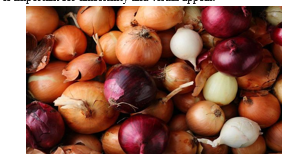Ijraset Journal For Research in Applied Science and Engineering Technology
- Home / Ijraset
- On This Page
- Abstract
- Introduction
- Conclusion
- References
- Copyright
Smart Onion Grading System: Integrating Temperature Control and Gas Sensing for Enhanced Quality Maintenance
Authors: Ms. C. P. Gowthami, Ranjith Kumar R, Dilli Babu I, Monish A
DOI Link: https://doi.org/10.22214/ijraset.2024.60815
Certificate: View Certificate
Abstract
India stands as the world\'s second-largest producer of onions, highlighting its significant role not just as a vegetable staple but also as a key contributor to foreign exchange earnings in the realm of fruits and vegetables. However, the variability in India\'s climate poses a challenge, often leading to the rot or decay of onions. Consequently, preserving onions becomes imperative, and adhering to the temperature guidelines outlined by the National Onion Association (NOA) is crucial. According to NOA, onions are best stored at temperatures ranging from 0 to 4°C alongside a humidity level of 60 to 70%. To address this issue, we have developed an onion preservation system that meticulously maintains onions within the specified parameters. Our system employs temperature and humidity sensors to continuously monitor these conditions. Utilizing a Peltier module, the system regulates the air temperature within the storage tank, ensuring it remains within the recommended range. Additionally, users gain access to up-to-date market trends pertaining to onions, enhancing their decision-making capabilities.
Introduction
I. INTRODUTION
Onions are a fundamental component of global agriculture and cuisine, with vast quantities harvested annually and distributed across various markets worldwide. However, ensuring the quality and longevity of onions during storage and transportation presents significant challenges to farmers, distributors, and retailers alike. The onion grading system is a method used to sort onions into different categories or grades based on various quality attributes such as size, colour , shape, firmness, and absence of defects. This process is essential for ensuring that onions meet specific standards and requirements set by producers, distributors, and consumers. The grading process typically involves the following steps:
- Size Sorting
Onions are initially sorted based on size and appearance. Larger onions are usually preferred for certain markets or culinary purposes, while smaller onions may be suitable for different uses.
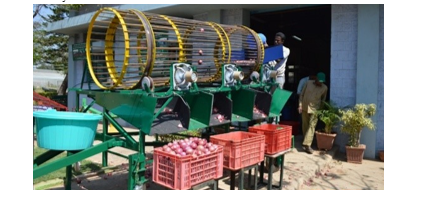
2.Colour Sorting
Onions are often categorized based on their colour, with categories such as white, yellow, and red onions being common. Colour consistency within each category is important for uniformity and visual appeal.
3. Inspection for Defects
Onions are inspected for defects such as bruises, cuts, rot, sprouting, and discoloration. Onions with significant defects may be discarded or sorted into lower-grade categories.
4. Firmness Testing
Onions should have a firm texture and feel heavy for their size, indicating freshness and quality. Soft or spongy onions may be sorted into lower-grade categories.
5. Sizing
Onions are often graded based on their size, with categories such as jumbo, medium, and pearl onions being common. Sizing is usually determined by diameter or weight.
A. Overview of Smart Onion Grading System
The Smart Onion Grading System represents a groundbreaking advancement in the agricultural industry, specifically targeting the onion production sector. Onions are a staple ingredient in many cuisines worldwide and are extensively cultivated, making their quality maintenance a critical concern for farmers, distributors, and consumers alike. The traditional methods of onion grading often rely on manual inspection, leading to inconsistencies and inefficiencies in the process. Moreover, onions are perishable commodities susceptible to spoilage, making the need for effective quality control measures imperative throughout the supply chain. In response to these challenges, the Smart Onion Grading System offers a sophisticated solution by integrating temperature control and gas sensing technologies to enhance quality maintenance throughout the onion production and distribution process. By leveraging cutting-edge sensing and automation technologies, this system aims to revolutionize the way onions are graded, monitored, and preserved, ultimately improving their shelf life, freshness, and overall quality. The integration of temperature control mechanisms ensures that onions are stored and transported under optimal conditions, minimizing the risk of spoilage and preserving their quality from farm to fork. Additionally, the incorporation of gas sensing capabilities enables real-time monitoring of environmental conditions, detecting any deviations that may indicate the onset of spoilage or degradation in onion quality. This work provides a comprehensive overview of the Smart Onion Grading System, detailing its design, functionality, and potential applications. By combining innovative technologies with agricultural practices, this system offers a holistic approach to onion quality maintenance, addressing key challenges faced by stakeholders in the onion supply chain. Through detailed analysis and experimentation, the effectiveness and feasibility of this system are evaluated, showcasing its potential to revolutionize onion grading and quality control practices in the agricultural industry.
B. Characteristics of Problem Statement
The traditional methods of onion grading rely heavily on manual inspection, leading to inconsistencies, inefficiencies, and subjective judgments in the grading process. Manual grading is labour- intensive, time-consuming and prone to errors, resulting in variations in quality assessment and classification across different grading facilities. Moreover, manual grading may overlook subtle defects or variations in onion quality, leading to inaccuracies and discrepancies in the graded product.
Additionally, the perishable nature of onions poses challenges for quality maintenance throughout the supply chain. Onions are susceptible to spoilage, sprouting, and deterioration in quality due to factors such as temperature fluctuations, humidity levels, and exposure to gases. Without effective monitoring and control mechanisms, onions may lose freshness, shelf life, and market value during storage, transportation, and distribution.
Furthermore, the lack of standardized grading criteria and quality control measures contributes to uncertainty and inefficiencies in the onion market. Buyers may face difficulties in assessing the quality and value of onions, leading to disputes, price fluctuations, and dissatisfaction with purchased products. This lack of transparency and consistency in grading practices hinders market efficiency and undermines consumer confidence in onion products.
In light of these challenges, there is a pressing need for an advanced onion grading system that integrates automation, sensing technologies, and standardized grading criteria to enhance accuracy, efficiency, and quality control in the onion grading process. Such a system would enable objective and consistent grading of onions, improve quality maintenance throughout the supply chain, and enhance market transparency and consumer trust in onion products.
C. Scope of the Study
The scope of the study encompasses the development and implementation of an advanced onion grading system that integrates automation, sensing technologies, and standardized grading criteria to enhance accuracy, efficiency, and quality control in the onion grading process.
Designing and developing a prototype onion grading system that incorporates automation, sensing technologies (such as computer vision and machine learning), and standardized grading criteria to enable objective and consistent grading of onions .Exploring and evaluating different sensing technologies for detecting onion quality attributes such as size, colour, shape, firmness, and defects. This may involve the use of cameras, sensors, and other detection methods to capture and analyze data from onions. Implementing automation and grading algorithms to process sensory data, classify onions into different grades based on predefined criteria, and generate accurate grading results. This may include developing machine learning models for pattern recognition and classification tasks. Investigating methods for ensuring quality control and assurance throughout the onion grading process, including monitoring environmental conditions, detecting spoilage or defects, and implementing corrective actions is done to maintain onion quality. Various experiments are conducted and validation studies are performed to assess the performance, accuracy, and reliability of the developed onion grading system. This may involve testing the system with different onion varieties, sizes, and quality levels under various conditions.
D. Scope of the Study
This proposed work aims to enhance the efficiency and accuracy of onion grading by employing an ESP32 controller and sensor technology. This approach facilitates automated grading processes, ensuring consistency and objectivity in quality assessment across different batches of onions. Additionally, the integration of irradiation techniques with low doses is explored to optimize onion preservation during storage and transportation, effectively controlling sprouting issues.
By addressing the challenges associated with prolonged storage periods, the study aims to enhance the market readiness and shelf life of the graded onions, thereby meeting consumer demands for fresh and high-quality produce. Furthermore, the implementation of these technologies is expected to yield economic gains by reducing sprouting losses and ensuring the delivery of high-quality onions to the market. This not only enhances the profitability of onion producers but also benefits stakeholders in the onion supply chain by improving market competitiveness and consumer satisfaction. Overall, the project seeks to contribute to the advancement of onion grading and preservation practices, ultimately promoting sustainability and efficiency in the onion industry.
E. Objectives
This proposed work aims to enhance the efficiency and accuracy of onion grading by employing an ESP32 controller and sensor technology. This approach facilitates automated grading processes, ensuring consistency and objectivity in quality assessment across different batches of onions. Additionally, the integration of irradiation techniques with low doses is explored to optimize onion preservation during storage and transportation, effectively controlling sprouting issues. By addressing the challenges associated with prolonged storage periods, the study aims to enhance the market readiness and shelf life of the graded onions, thereby meeting consumer demands for fresh and high-quality produce. Furthermore, the implementation of these technologies is expected to yield economic gains by reducing sprouting losses and ensuring the delivery of high-quality onions to the market.
This not only enhances the profitability of onion producers but also benefits stakeholders in the onion supply chain by improving market competitiveness and consumer satisfaction .Overall, the project seeks to contribute to the advancement of onion grading and preservation practices, ultimately promoting sustainability and efficiency in the onion industry.
II. METHODOLOGY
The methodology for addressing the difficulties in classifying the ripeness of oil palm fruit and improving real-time detection and classification using a smart phone involves several key steps:
A. Dataset Collection and Annotation
The first step is to collect a comprehensive dataset of oil palm fruit images representing various ripeness levels. These images are annotated with labels indicating the ripeness category of each fruit. Additionally, variations in lighting conditions, backgrounds, and orientations are considered to ensure robustness and generalization of the model
B. Model selection and Modification
Next, a suitable deep learning model is selected for real-time detection and classification of oil palm fruits. Given the efficiency requirements for deployment on mobile devices, the YOLOv4 object detection algorithm is chosen as the base model.However, modifications are made to optimize its performance for real-time inference on smart phones, such as reducing model complexity and adapting architecture to mobile hardware constraints
C. Training and Fine-Tuning
The selected model is trained on the annotated dataset of oil palm fruit images using transfer learning techniques. By fine-tuning the pre-trained model on the specific task of fruit detection and ripeness classification, the model learns to accurately identify and categorize oil palm fruits in real-time.
D. Evaluation and Validation
The trained model is evaluated using a separate test dataset to assess its performance in terms of accuracy, speed, and robustness. Metrics such as precision, recall, and F1-score are used to quantify the model's performance, while real-world testing on smart phone devices validates its real-time capabilities and efficiency.
III. SYSTEM ARCHITECTURE
A. Architecture Diagram
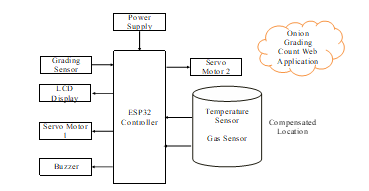
The block diagram outlines the components and structure of an automated system designed for grading and counting onions. The central controller of the system is an ESP32, a popular microcontroller with WiFi capabilities, which manages the various sensors and actuators .On the input side, there's a VL53L0X Time-of-Flight (ToF) sensor, which is used for measuring distances and could be integral in determining the size or presence of onions for grading purposes. LCD display used for real-time status updates, and an SG90 servo motor is responsible mechanism for sorting the onions based on their grading.
For monitoring the environment or storage conditions, there are NTC temperature and MQ135 gas sensors in monitoring the storage climate to ensure the onions are kept in optimal conditions, with the MQ135 detecting harmful gases or abnormal levels of compounds that could indicate spoilage.
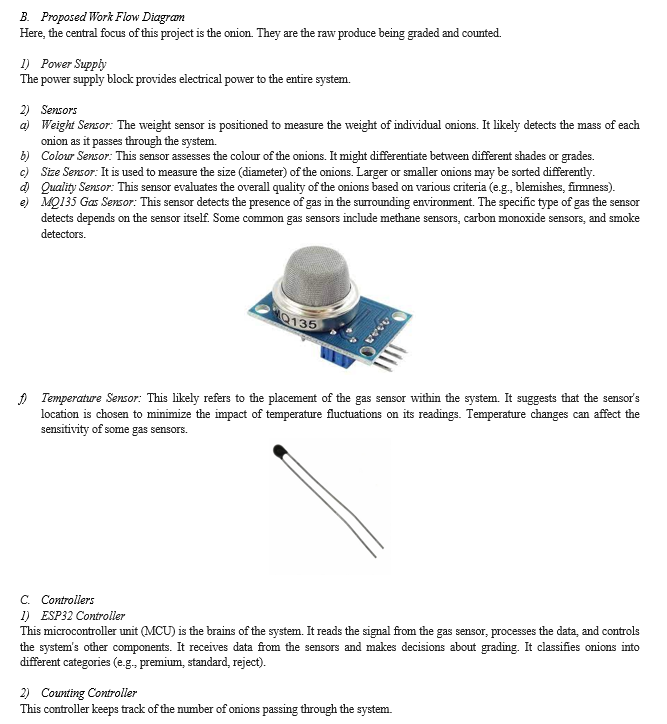
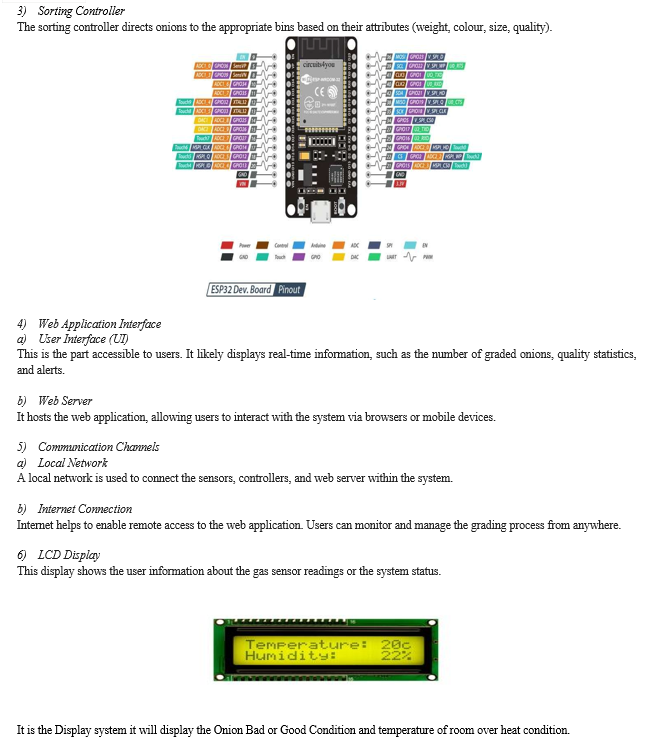
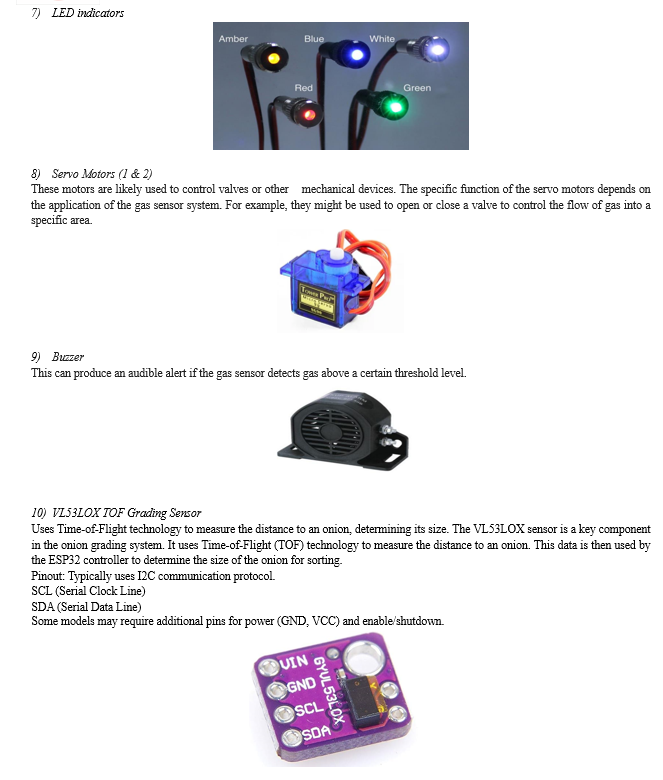
IV. SYSTEM SPECIFICATIONS
A. Hardware Components
- ESP3
- VL53LOX TOF
- MQ135 Gas Sensor
- SG 90 Servo Motor
- NTC Temperature sensor
- LCD Display
- Power Supply board
- 12v 2A adaptor
B. Software Components
- Arduino IDE.
- Embedded C
C. Hardware And Software Description Worflow
The data flow involves the movement of onion along a conveyor belt, where various sensor collect data such as weight, colour, size,and quality. This data is then proceed by controllers, which analyze the information and make decision based on predefined criteria or algorithms. Subsenquently, then graded onions are sorted into appropriate bins based on the decision made by the controllers. Additionally, a web applications is utilized to monitor and update the sorting process in real-time. onions are transport along a conveyor belt system, which serves as a means of conveying them throught the grading process. The conveyor belt ensure a continuous flow of onions, allow them to be efficiently processed without interruptions. Along the conveyor belt, various sensors are strategically placed to collect data about the oinion passing through. These ssensor may include weighing scales to measure the weight of each onion, colour sensors may predefined paramenter. The data collect by the sensor is transmitted to controlles, which are responsible for processing the informations and making decision based on predetermined criteria or algortjims.
V. OUTPUT AND RESULT
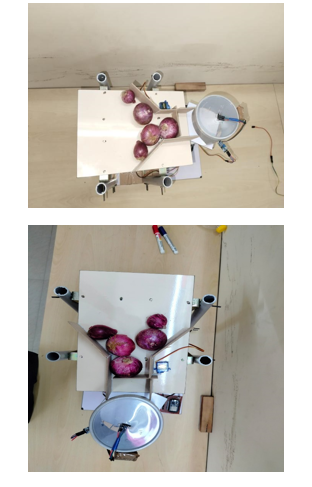
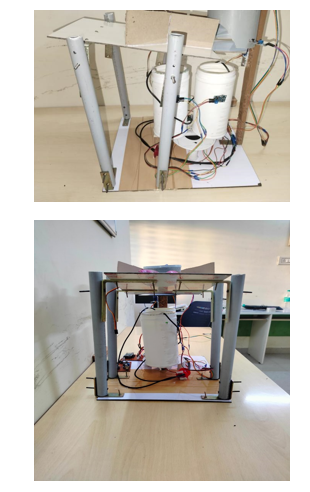
Conclusion
A. Conclusion The Smart Onion Grading System represents a significant advancement in the field of agricultural technology, particularly in the domain of onion production and quality maintenance. By integrating temperature control and gas sensing technologies, this system addresses the critical need for efficient and accurate onion grading, ensuring enhanced quality maintenance throughout the supply chain. Through the integration of state-of-the-art sensors and automation mechanisms, the Smart Onion Grading System offers several key benefits. Firstly, it enables precise and objective grading of onions based on various quality attributes, such as size, colour and firmness. This ensures consistency and reliability in the grading process, mitigating the risk of subjective judgments and human error. Moreover, the system\'s temperature control capabilities play a crucial role in preserving onion freshness and extending shelf life. By maintaining optimal storage conditions, the system minimizes the risk of spoilage and deterioration, thus enhancing the overall quality and marketability of the graded onions. Furthermore, the integration of gas sensing technology allows for real-time monitoring of environmental conditions, particularly gas levels that may indicate the onset of spoilage or degradation. This proactive approach to quality control enables timely interventions and corrective actions, thereby minimizing product losses and maximizing yield and profitability for onion producers and distributors. In conclusion, the Smart Onion Grading System represents a holistic solution for enhancing onion quality maintenance and optimizing supply chain efficiency. By leveraging advanced technologies and automation, this system not only streamlines the grading process but also ensures superior product quality and freshness, ultimately benefiting stakeholders across the onion industry. With its potential to revolutionize onion grading practices, the Smart Onion Grading System sets a new standard for quality assurance and sustainability in agricultural production. B. Future Works The future scope of the Smart Onion Grading System involves leveraging advanced technologies to further enhance efficiency, accuracy, and sustainability in onion grading processes. Integration of machine learning algorithms can refine grading accuracy by analyzing historical data and continuously improving classification models. Additionally, incorporating IoT devices enables remote monitoring and management, allowing stakeholders to access real-time data and optimize operations. Further advancements may include expanding environmental monitoring capabilities to include factors like humidity and air quality for comprehensive spoilage prevention. Implementation of block chain technology ensures transparent supply chain tracking, fostering trust and accountability among stakeholders. Moreover, developing a mobile application facilitates stakeholder engagement and provides valuable insights into grading results and market trends. Expanding the system\'s applicability to other agricultural products, along with sustainability initiatives such as eco-friendly practices and packaging solutions, contributes to broader industry advancements. Furthermore, tailoring the system for international markets facilitates global market expansion, opening up new opportunities for onion grading technology adoption worldwide. By pursuing these initiatives, the Smart Onion Grading System continues to evolve, driving innovation and efficiency in onion grading processes while promoting sustainability and transparency across the agricultural industry.
References
[1] Jui-feng yeh, kuei-mei lin;chen-yu lin; jen-Chun Kang [2] Hieu M. Tran , Kien t. Pham , Thanh m. Vo, Tat-Hien le,, Tri t. M. Huynh, and Son vu Truong Dao [3] Suharjito, (Member, IEEE), Muhammad Asrol, ditdit Nugeraha Utama, Franz Adeta Junior , and Marimin
Copyright
Copyright © 2024 Ms. C. P. Gowthami, Ranjith Kumar R, Dilli Babu I, Monish A. This is an open access article distributed under the Creative Commons Attribution License, which permits unrestricted use, distribution, and reproduction in any medium, provided the original work is properly cited.

Download Paper
Paper Id : IJRASET60815
Publish Date : 2024-04-23
ISSN : 2321-9653
Publisher Name : IJRASET
DOI Link : Click Here
 Submit Paper Online
Submit Paper Online


